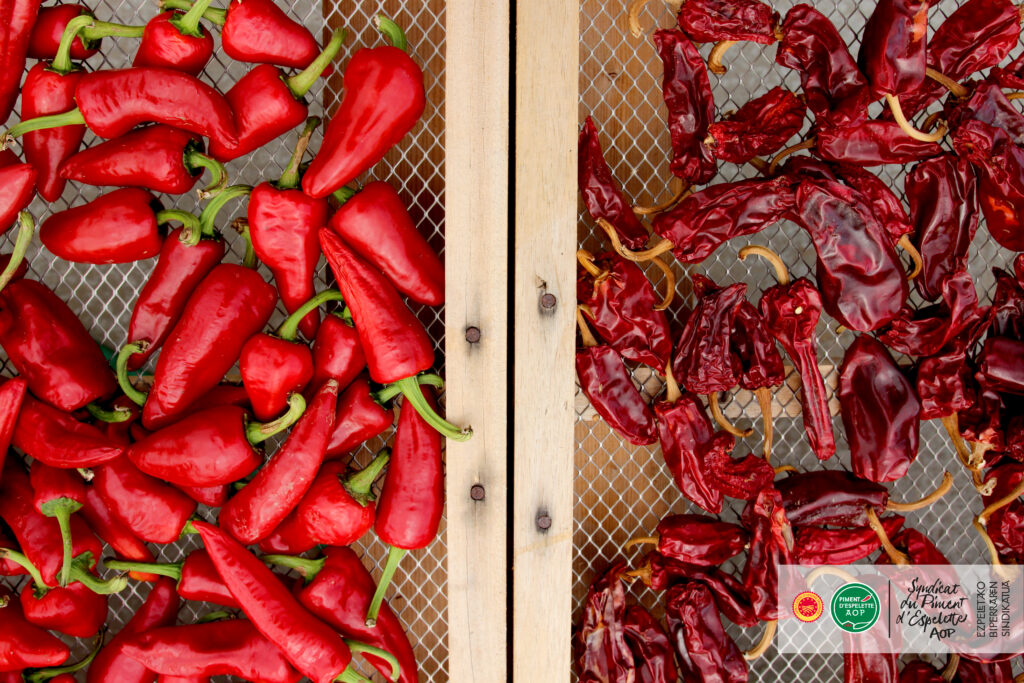Piment d’Espelette means, simply, pepper from Espelette, which is a village in the French Basque country in the Pyrenees, close to the Spanish border.
The pepper itself is called Gorria, Basque for “red.”
The vibrant red chilli pepper spice has been captivating the culinary world; it is one of the oldest such spices in Europe that have enough of a pedigree to have been awarded a controlled designation of origin.
As with all chile peppers and especially chile pepper powders, if one only looks at it in terms of pungency, it is just another chilli. If one considers the differences to others, let alone dives deeper into the history, it opens a fascinating world of complex heat.
Characteristics:

© Photothèque Piment d’Espelette AOP
Botany:
Piment d’Espelette belongs to the species Capsicum annuum.
While the term “pepper” encompasses the plant, pod, seed, and spice, Piment d’Espelette specifically refers to the dried and ground fruit of this particular chili pepper .
Though its origins lie in Central and South America, Piment d’Espelette has been cultivated in the Basque region of France for centuries.
The unique terroir of the region, with its specific climate and soil conditions, contributes to the pepper’s distinct flavor profile, much like the way specific regions influence the taste of wine or cheese .
Appearance:
Piment d’Espelette peppers are rather plump, conical peppers with a deep red color when ripe.
Once harvested, the peppers are traditionally strung together and hung to dry in the sun, creating a vibrant display of red that adorns the houses and buildings in the Basque region
This drying process is crucial for developing the pepper’s unique flavor and aroma.The dried peppers are ground into a fine powder.
Flavor Profile:
The flavor of Piment d’Espelette is complex and well-balanced.
It offers a mild to moderate heat level, along with sweet fruity undertones reminiscent of sun-dried tomatoes or raisins. A subtle smokiness adds depth and complexity to its taste.
Growing Region and Cultivation:
Piment d’Espelette peppers are exclusively grown in the designated area around the town of Espelette in the French Basque Country.
Aside from Espelette itself, this also includes Cambo-les-Bains (a spa town that is home of the Gateau Basque and the place where Edmond Rostand wrote Cyrano de Bergerac), Aïnhoa, Halsou, Itxassou, Jatxou, Larressore, Saint-Pée-sur-Nivelle, Souraïde and Ustaritz.

© Photothèque Piment d’Espelette AOP
The unique microclimate and soil conditions of this region contribute to the peppers’ distinct flavor profile. The peppers are typically hand-picked and then slowly dried in the sun or in specially designed drying houses.
History:
Legend has it that a Basque sailor who had accompanied Christopher Columbus on his voyage(s) to the Americas brought the first chilli right to the Basque country.
Research finds that it has been grown commercially in the area of Espelette since 1650.
The name “Piment d’Espelette” emerged in the 19th century, associated with the town of Espelette, a central hub for its trade. Today, it’s cultivated in ten communes within the French Basque region (see above), with Espelette remaining a key center for its production and celebration.
Economic and Cultural Significance
Piment d’Espelette holds immense economic and cultural importance for the Basque region.
Its cultivation, processing, and trade provide livelihoods for many families, contributing significantly to the local economy.
The pepper’s cultural significance is deeply rooted in Basque traditions. The annual pepper festival in Espelette, the Fête du Piment, held since 1968, draws thousands of tourists and celebrates the harvest with vibrant displays of drying peppers hung on balconies and houses.
This visual spectacle speaks to the pepper’s integral role in Basque identity and heritage. Piment d’Espelette is more than just a spice; it represents a connection to the land, a celebration of tradition, and a source of pride for the Basque people.
Protecting the Tradition: The AOC Designation
Since 2000, Piment d’Espelette (Espeletako Biperra) is officially recognized as a product with a protected designation of origin (originally AOC, since 2009 AOP/PDO).
It is the only French spice with this designation.
This recognition underscores its authenticity and traditional production methods, ensuring that only peppers grown in the designated area and following strict guidelines can bear the name “Piment d’Espelette.”
The protection and management of the AOC are overseen by the Syndicat du Piment d’Espelette, a cooperative of producers, processors, and packagers.
This organization works in partnership with institutional partners like INAO (Institut National de l’Origine et de la Qualité), CERTISUD (an external control authority), and DGCCRF (Direction générale de la Concurrence, de la Consommation et de la Répression des fraudes).
Culinary Significance:
Piment d’Espelette is prized for its unique flavor profile, described as sweet and fruity with a mild heat that registers at 4,000 Scoville heat units (SHU).
This moderate heat is complemented by notes of berries and a subtle smokiness, creating a complex and balanced flavor that enhances rather than overpowers dishes.
It’s this balance of flavors and gentle heat that makes Piment d’Espelette a prime example of the “complex heat” trend.
In Basque cuisine, Piment d’Espelette is incredibly versatile.
It’s a key ingredient in piperade, a classic Basque dish made with peppers, onions, and tomatoes, where its flavor harmonizes perfectly with the sweetness of the vegetables and adds a delicate warmth.
It is equally as, if not more, important in axoa, a slow-cooked veal stew that is a cornerstone of Basque cuisine.
Beyond piperade and axoa, it’s used in a wide range of dishes, from stews and sauces to marinades and even chocolate
Here are some examples of how Piment d’Espelette is used to create complex heat:
Main Courses:
- Poulet Basquaise: A traditional chicken stew where Piment d’Espelette adds a warm, subtle spice to the rich flavors of the dish.
Sauces and Condiments:
- Piment d’Espelette can be infused into vinegar, olive oil, and honey to create flavorful bases for vinaigrettes and sauces.
- It can be added to mayonnaise, béchamel, and other sauces to provide a subtle kick and depth of flavor.
Desserts and Snacks:
- Chocolate: The unexpected combination of Piment d’Espelette with chocolate creates a surprising and delightful flavor experience, where the pepper’s warmth and fruitiness enhance the richness of the chocolate.
- Piment d’Espelette can also be used in jellies and other sweet treats to add a unique twist.
- Of course, one can find Piment d’Espelette as flavoring of spicy potato chips.
Other Applications:
- Seafood: Piment d’Espelette’s mild heat and fruity notes pair beautifully with grilled fish or shellfish, adding a delicate warmth and depth of flavor.
- Vegetables: Roasting vegetables with a sprinkle of Piment d’Espelette brings out their natural sweetness while adding a subtle kick.
- Eggs: From omelets to deviled eggs, Piment d’Espelette elevates egg dishes with its unique flavor and gentle heat.
Its versatility extends beyond traditional Basque cuisine, finding its way into modern culinary creations and fusion dishes.
Beyond Basque Cuisine:
While deeply rooted in Basque culinary traditions, Piment d’Espelette has gained international recognition for its exceptional flavor and versatility. It is now used by chefs and home cooks worldwide to add a touch of Basque flair to their dishes.
Overall, Piment d’Espelette is a unique and flavorful chili pepper that showcases the terroir of the Basque region.
Its combination of mild heat, fruity notes, and smoky undertones makes it a sought-after ingredient for those seeking to explore the nuanced flavors of chili peppers beyond mere spiciness.
Reply